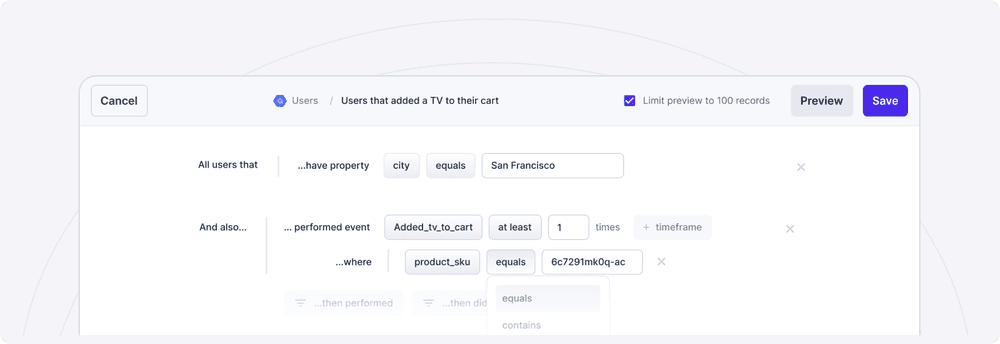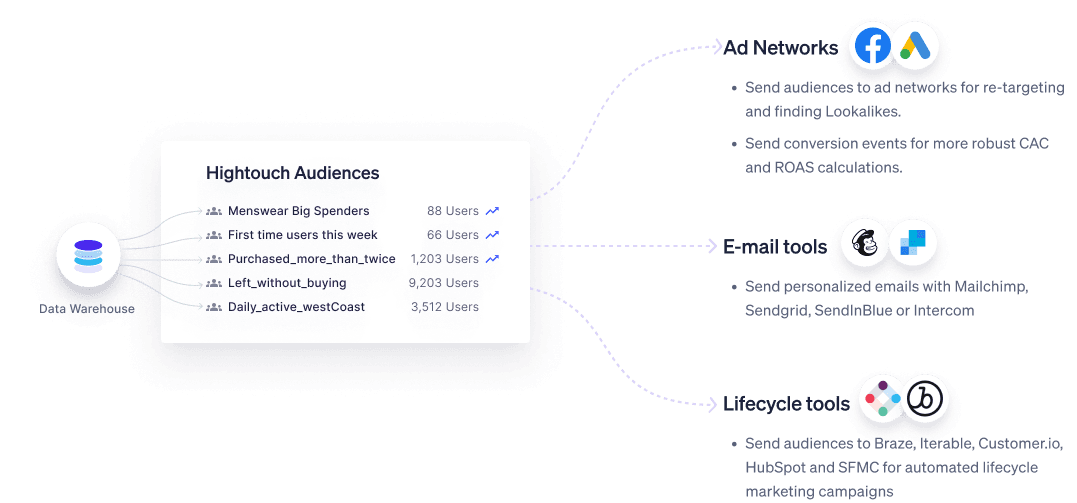You have this amazing idea for a marketing campaign: sending your customers this congratulatory Gif after they complete their first purchase. Genius, right?

You have the copy written. All that's left to do is to get a CSV with all of your customers that made a recent purchase: sounds simple. You ask your lovely data team for the CSV, and bam! You're told to add a JIRA ticket in a never ending backlog of 100 other data requests from across the company. The earliest they can get to your ticket is next month. What do you do now?
We've all been there before. But why is this the norm? Here at Hightouch, we believe that everyone should be able to use data to personalize the experience of their customers. Today, we move one step closer to that vision with our latest product for Marketers: Hightouch Audiences.
Goodbye CSVs, Hello Hightouch Audiences
Hightouch Audiences allows marketers to define audiences to target for marketing campaigns and sync those audiences to any of their marketing tools like email or ad tools: no engineering favors required. As a marketer, you can use our Visual Audience Builder to visually define and filter audiences in an intuitive UI, without needing to know SQL.
Once you define an audience, it will continually sync new members of that audience to your tools: no more having to upload a new CSV every week.


Use Cases
Previously, the data warehouse was only accessible by SQL-savvy team members. With Hightouch Audiences, the power of your data warehouse is democratized so that anyone can personalize customer experiences for use cases such as:
-
Lifecycle marketing: Send lifecycle marketing campaigns to customers across any channel as soon as they invite a friend or abandon a shopping cart
-
Target Your Paid Ads: Increase your ROAS by retargeting customers who visited your pricing page or excluding customers who already purchased
-
Create lookalike audiences: Find new customers similar to your existing high value customers in all of your ad networks like Facebook and Google
-
Send Conversion Events: Send conversion events to any ad network to optimize your targeting, reduce your CAC and provide enhanced ROAS reporting
So, how does it work exactly?
You can think of Hightouch Audiences as the glue between marketing and data teams.
-
First, data teams define models and relationships. With just a SQL query or dbt model, data teams can define the data that Marketing can access (columns, tables, etc). Hightouch is flexible and supports any data available in your warehouse: Users, Accounts, Workspaces, Products, etc.
-
Next, marketing teams create audiences on top of data models. Marketing teams can visually filter audiences based on any properties or events. For example, you can choose an audience of users who purchased a certain item or live in a certain city.
-
Then, audiences are synced to marketing tools. Audiences can be synced to CRMs, ad networks like Facebook, marketing automation tools like Marketo, lifecycle marketing tools like Braze or Iterable, email tools like Mailchimp and 250+ destinations other tools.
-
Finally, marketing teams can run campaigns on those audiences. You can deliver personalized messaging to those audiences in your marketing tool and channel of choice, such as email, SMS or in-app.
Where does Hightouch Audiences sit within my marketing stack?
Hightouch Audiences acts as the central data source of your marketing stack that enables you to run multi-channel campaigns in all of your tools. For example, you can define an audience of users who visited your pricing page. Then, you can sync that audience to your email tool (ex: Mailchimp) for a personalized pricing email and retarget them on ad networks (ex: Facebook) to get them to convert. All you need to do is define your audience once, and Hightouch takes care of making that audience available in 250+ destinations different tools.

What makes Hightouch Audiences unique? How does it relate to a CDP?
Most CDPs (Customer Data Platform) and audience builders like Segment trap you in a rigid data model, lock you to use just Events and Users, store your data, and hit rate limit issues at scale. The key difference between Hightouch Audiences and any other audience builder is that Hightouch is more flexible. How? Because it works on top of your data warehouse, which is the single source of truth for your business. Your warehouse has the full picture of your customers, including product actions, billing information and even 3rd party data sources.
All this context on your customers allows you to create powerful audiences. You can even use Custom Objects specific to your business (like Workspaces, Accounts, Products, etc): for example, filtering all customers who bought a specific Product or belong to a high value Account. And your data stays in your warehouse, keeping your precious customer data safe within your systems (which is especially needed for regulated industries like Fintech and Healthcare). That's something a CDP (Customer Data Platform) can't do.
Regarding event collection and sending data to the warehouse, Hightouch is vendor-agnostic. Although Hightouch offers its own Events data collection product, it still works with other solutions like Snowplow.
Is Hightouch going to replace BI tools like Looker, Amplitude or Mixpanel?
BI tools like Looker have also made data accessible to more people in a company, but at the end of the day, they are focused more on analytics (hence, "business intelligence") than activation ("putting data to work"). In order to activate data in BI Tools, it's still fundamentally all about CSVs. Hightouch Audiences is even more accessible given our intuitive Visual Audience Builder, and even more powerful and automated than CSVs because it connects directly to your marketing tools. This saves you time from doing manual work and helps you automate your campaigns.
What data does Hightouch Audiences use? What setup is required?
Hightouch Audiences requires that you have a data warehouse or data lake that has event data on how your users are interacting with your product. Hightouch does not replace your existing event tracking or ELT workflows: in fact, it enhances it. The more data you make available in your warehouse (such as billing data from Stripe, sales data from Salesforce, etc), the more powerful your audiences can be.
Does Hightouch support real time?
You need to reach customers when your message is most relevant to them, like the example above of sending a gif as soon as a customer completes a purchase (not 10 minutes later). Hightouch supports real-time use cases: it can send data to marketing tools as soon as an event lands in your warehouse, or you can use a streaming data source like Snowplow, Segment, Kinesis or Kafka.
How do I try out Hightouch Audiences?
Learn more about Audiences and book a demo here.















